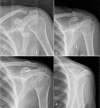Clinical and Radiological Outcomes of Closed-Loop, Double Button, Coracoclavicular Fixation for Extralateral (Neer Type IIC) Fractures of the Distal Clavicle
- PMID: 35755557
- PMCID: PMC9217673
- DOI: 10.7759/cureus.25228
Clinical and Radiological Outcomes of Closed-Loop, Double Button, Coracoclavicular Fixation for Extralateral (Neer Type IIC) Fractures of the Distal Clavicle
Abstract
Background: The distal end of the clavicle accounts for 10-28% of all clavicle fractures of which 52.8% are considered displaced and require internal fixation due to their high percentage of non-union. Numerous surgical techniques have been described for the well-known Neer types IIA, IIB, and V. Still, the literature is scarce for the rare "extralateral" (type IIC) fracture where the fracture line is located lateral to the completely torn coracoclavicular (CC) ligaments; such small fractures are sometimes not amenable for standard locking plate fixation.
Methods: We present a series of seven patients treated surgically with closed-looped double button CC stabilization via an open approach. There were four males and three females with a mean age of 31 years (range: 19-46 years). The mechanism of injury was a motor vehicle accident in four cases and a fall from height in three cases. The average time from injury to surgery was 2.7 ± 1.3 days and the average follow-up period was 25.7 months (range: 16-48 months). A custom-made, closed-looped, double button device was made using the ProCinch Adjustable Cortical Fixation for anterior cruciate ligament (ACL) (Stryker, Kalamazoo, Michigan) and another standard or slotted button. The fracture was reduced anatomically and the device was tightened and secured with five to six knots. In two cases, additional interfragmentary sutures were used for extra stability. Postoperatively, the arm was immobilized in a simple sling for four weeks; passive assisted elevation up to 90 degrees was allowed from the second postoperative week, followed by active elevation after the sixth postoperative week. Radiological outcomes (bony union, loss of reduction, implant mispositioning, or subsidence of buttons) were assessed using serial plain radiographs. The Constant score (CS) and the Acromioclavicular Joint Instability Score (AJIS) were used for the final clinical evaluation, at least one year postoperatively.
Results: Bony union was achieved in all patients at a mean time of 2.7 months (range: 2.5-3.6 months). No cases of delayed union, loss of reduction, button migration, or subsidence were noted. The mean CS was 96.6 ± 3.4 and the mean AJIS score was 94.1 ± 4.7 in a mean follow-up period of 25.7 months (range: 16-48 months). One patient developed a hypertrophic scar and another had mild skin irritation by the suture knots; no other complications were noted except for one patient who developed an early superficial skin infection managed with antibiotics and debridement under local anesthesia. Four patients who participated in sports before injury were able to regain almost full activity seven to nine months after the operation. All were satisfied with the final result. Two patients showed ossification of the CC ligaments with no significant clinical implications.
Conclusions: Although we retrospectively reviewed a small series of patients, we were able to demonstrate a complete rate of fracture union and excellent clinical outcomes with no major complications. Type IIC distal clavicle fractures are rare and require special attention in terms of reduction and optimal fixation. Open CC fixation with closed-looped double buttons is a relatively easy and reproducible technique. We advocate the readjustment of Neer's classification, including "extralateral" fractures as a IIC subtype.
Keywords: cho type iic; closed-loop double button; coracoclavicular stabilization; distal end clavicle fractures; neer type iib.
Copyright © 2022, Panagopoulos et al.
Conflict of interest statement
The authors have declared that no competing interests exist.
Figures



Similar articles
-
Coracoclavicular fixation techniques for Neer IIb and "extralateral" fractures of the distal clavicle: a systematic review.JSES Rev Rep Tech. 2021 Aug 12;4(4):676-683. doi: 10.1016/j.xrrt.2021.06.007. eCollection 2024 Nov. JSES Rev Rep Tech. 2021. PMID: 39474195 Free PMC article. Review.
-
All arthroscopic coracoclavicular button fixation is efficient for Neer type II distal clavicle fractures.Knee Surg Sports Traumatol Arthrosc. 2021 Jul;29(7):2064-2069. doi: 10.1007/s00167-020-06048-8. Epub 2020 May 7. Knee Surg Sports Traumatol Arthrosc. 2021. PMID: 32382804
-
[Effectiveness of anatomical locking plate internal fixation combined with coracoclavicular ligament reconstruction for Neer type Ⅱb distal clavicle fractures].Zhongguo Xiu Fu Chong Jian Wai Ke Za Zhi. 2018 Sep 15;32(9):1181-1186. doi: 10.7507/1002-1892.201803127. Zhongguo Xiu Fu Chong Jian Wai Ke Za Zhi. 2018. PMID: 30129329 Free PMC article. Chinese.
-
Fixing Cho Type IIC Distal Clavicle Fractures with Hook Plates Leads to a High Incidence of Subacromial Osteolysis: A Retrospective Study and Literature Review.Clin Orthop Surg. 2024 Oct;16(5):694-701. doi: 10.4055/cios24009. Epub 2024 Sep 13. Clin Orthop Surg. 2024. PMID: 39364106 Free PMC article. Review.
-
Precontoured Locking Compression Plate with Titanium Alloy Cable System: In Treatment of Neer Type IIb Distal Clavicle Fracture.Orthop Surg. 2021 Apr;13(2):451-457. doi: 10.1111/os.12893. Epub 2021 Jan 22. Orthop Surg. 2021. PMID: 33480180 Free PMC article.
Cited by
-
Symptomatic Nonunion of the Coracoid Process Following Osteosynthesis Using a Suture Button for Coracoid Process and Distal Clavicle Fracture: A Case Report.Am J Case Rep. 2024 Mar 28;25:e943108. doi: 10.12659/AJCR.943108. Am J Case Rep. 2024. PMID: 38544309 Free PMC article.
-
Comments on the Article "Comparison of Locking Plate Osteosynthesis versus Coracoclavicular Stabilization for Neer Type IIB Lateral Clavicle Fractures": To the Editor.Clin Orthop Surg. 2023 Jun;15(3):516-517. doi: 10.4055/cios22322. Epub 2023 Mar 27. Clin Orthop Surg. 2023. PMID: 37274493 Free PMC article. No abstract available.
-
A Retrospective Machine Learning Analysis to Predict 3-Month Nonunion of Unstable Distal Clavicle Fracture Patients Treated with Open Reduction and Internal Fixation.Ther Clin Risk Manag. 2025 May 5;21:633-645. doi: 10.2147/TCRM.S518774. eCollection 2025. Ther Clin Risk Manag. 2025. PMID: 40352661 Free PMC article.
References
-
- Management of distal clavicle fractures. Banerjee R, Waterman B, Padalecki J, Robertson W. J Am Acad Orthop Surg. 2011;19:392–401. - PubMed
-
- Craig EV. Fractures in Adults. Philadelphia, PA: Lippincott Williams & Wilkins; 2006. Fractures of the clavicle; pp. 1216–1217.
LinkOut - more resources
Full Text Sources
